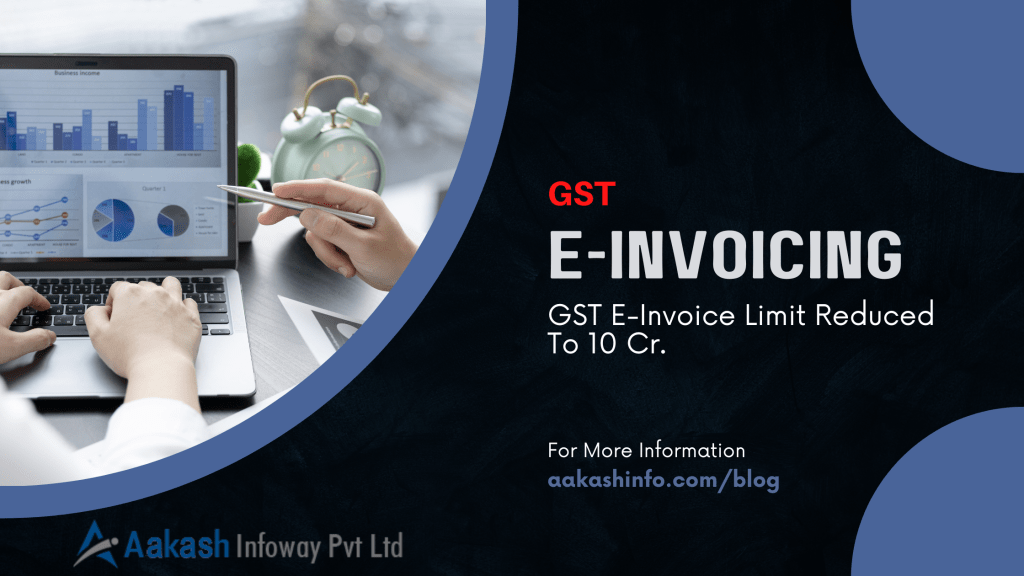Post Views: 101
GST E-Invoice Limit Reduced To 10 Cr. From Existing Limit Of 20 Cr. w.e.f 1st Oct 2022 Vide No. 17/2022

Every registered taxpayer who has an annual turnover of more than Rs. 10 Cr. since the start of the 2017–2018 fiscal year is required to send an e-invoice as of October 1, 2022. The limit used to be Rs. 20 Cr. The registered person who is required to issue an e-invoice must upload a json file containing their tax invoice to the Invoice Registration Portal (IRP) in accordance with the e-invoice schema in INV-01. They must then wait for the IRP to return a digitally signed json file along with an IRN and QR Code.
Ministry Of Finance
(Department of Revenue)
(Central Board of Indirect Taxes and Customs)
New Delhi
Notification No. 17/2022-Central Tax | Dated: 1st August, 2022
G.S.R. 612(E).– In exercise of the powers conferred by sub-rule (4) of rule 48 of the Central Goods and Services Tax Rules, 2017, the Government, on the recommendations of the Council, hereby makes the following further amendment in the notification of the Government of India in the Ministry of Finance (Department of Revenue), No. 13/2020 – Central Tax, dated the 21St March, 2020, published in the Gazette of India, Extraordinary, Part II, Section 3, Sub-section (i) vide number G.S.R. 196(E), dated 21st March, 2020, namely:‑
In the said notification, in the first paragraph, with effect from the 1st day of October, 2022, for the words “twenty crore rupees”, the words “ten crore rupees” shall be substituted.
[F. No. CBIC-20021/2/2022-GST]
Rajeev Ranjan, Under Secy.
Note : The principal notification No. 13/2020 – Central Tax, dated the 21st March, 2020 was published in the Gazette of India, Extraordinary, Part II, Section 3, Sub-section (i) vide number G.S.R. 196(E), dated the 21st March, 2020 and was last amended vide notification No. 01/2022-Central Tax, dated the 24th February, 2022, published vide number G.S.R. 159(E), dated the 24th February, 2022.
The following are some significant e-invoicing points to remember:
- Einvoice1.gst.gov.in is the official government website for creating electronic invoices.
- For taxpayers who fall inside the scope, this is an obligatory necessity and is not an option.
- Tax invoices produced without e-invoicing are deemed invalid and are subject to penalties.
- E-invoicing is not applicable to non-banking financial companies, goods and passenger transportation agencies, business units operating in SEZ, and government departments.
- E-invoicing will only apply to Business-to-Business (B2B) transactions and exports.
- GSTR 1 will automatically fill in with all B2B transactions containing e-invoice.
Aakash kothari
Share post:
GST E-Invoice Limit Reduced To 10 Cr. From Existing Limit Of 20 Cr. w.e.f 1st Oct 2022 Vide No. 17/2022
Every registered taxpayer who has an annual turnover of more than Rs. 10 Cr. since the start of the 2017–2018 fiscal year is required to send an e-invoice as of October 1, 2022. The limit used to be Rs. 20 Cr. The registered person who is required to issue an e-invoice must upload a json file containing their tax invoice to the Invoice Registration Portal (IRP) in accordance with the e-invoice schema in INV-01. They must then wait for the IRP to return a digitally signed json file along with an IRN and QR Code.
The following are some significant e-invoicing points to remember:
Follow Us On : Facebook, Twitter, Instagram, LinkedIn
Ref:- TaxGuru.in
E-invoicing will soon be required for businesses with a turnover of more than Rs.5-crore
Post Views: 53 Businesses who do not use e-invoicing will be deemed invalid and ineligible for ITC. Businesses having a yearly revenue of more than 10 crore rupees and a. read more…
Continue Reading